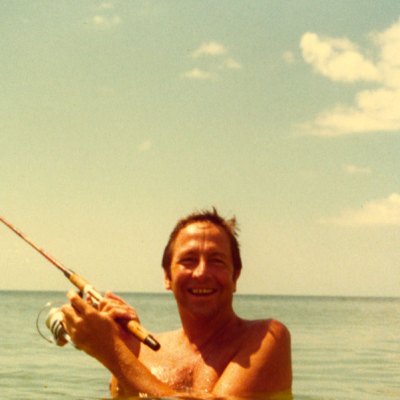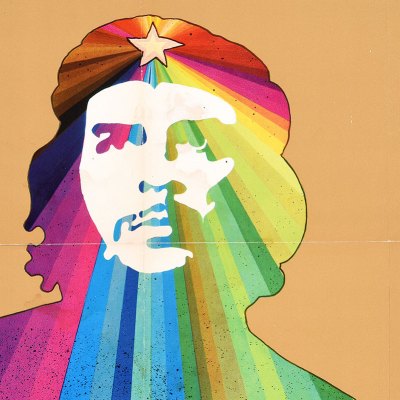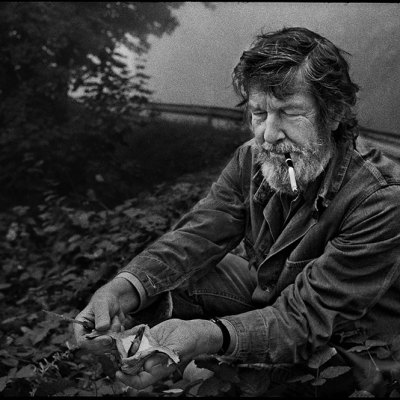By the 1980s, Robert Rauschenberg was just about the most famous living artist in America. He was one of the most prolific, too – a man who ‘invented more than any artist since Picasso’, his friend, collaborator and one-time lover Jasper Johns remarked. For Rauschenberg, collaboration was one outlet for his fecundity. He worked with dancers, writers and musicians throughout his career; he had John Cage drive his Ford Model A down the road over a 23-foot-long expanse of paper to create the artwork Automobile Tire Print in 1953 – the same year in which he solicited an original drawing from Willem de Kooning and then rubbed out the whole thing, exhibiting the blank-ish sheet of paper as Erased de Kooning Drawing, in gilded frame and mock-Renaissance monogramming added by Johns.
In 1984, inspired by a trip to China during which he witnessed draconian restrictions placed on Chinese citizens, Rauschenberg embarked on another, more altruistically minded collaborative project. The Rauschenberg Overseas Cultural Interchange (ROCI – pronounced ‘Rocky’, after the artist’s pet turtle), involved a series of visits over seven years to ‘societies less familiar with non-political ideas’: Mexico, Chile, Venezuela, China, Tibet, Japan, Cuba, the USSR, Germany and Malaysia. Rauschenberg would research and photograph each place, meet local artists and then head back to his studio in Florida, where he would make art inspired by his travels. The work would then be included in a touring exhibition to those countries, alongside some of his older pieces, giving foreigners access to a titan of American art while also diversifying Rauschenberg’s own oeuvre. ROCI is ‘a multi-media aggressive art attack,’ he scrawled in a tract displayed at a new exhibition dedicated to the project at Thaddaeus Ropac in London, ‘to prove that a 1 to 1 artistic contact with the peoples of the world will produce peace and understanding’.
Cuban Slate (Pizzaron Cubano)/ROCI CUBA (1988), Robert Rauschenberg. Courtesy Thaddaeus Ropac gallery, London, Paris, Salzburg, Seoul; © Robert Rauschenberg Foundation/ARS, New York 2021
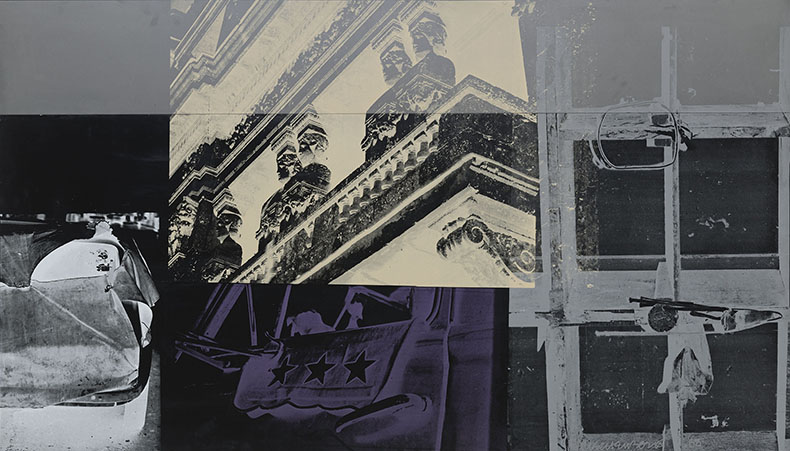
As artistic aims go, world peace is about as ambitious (or delusional) as it gets. Looking back at ROCI now, there is, at best, a sense of naive utopianism and, at worst, an imperialistic overtone to the whole endeavour. It’s a topic that this otherwise excellent show never quite gets its teeth into, which is an oversight, especially since it’s hardly an anachronistic criticism. Reviewing the final ROCI show in Washington, D.C., in 1991, the New York Times critic Roberta Smith described the project as ‘at once altruistic and self-aggrandizing’. Paul Richard, writing in the Washington Post, branded Rauschenberg an ‘art imperialist’. According to the exhibition catalogue, people in China today still divide the late 20th century, in artistic terms, into the periods ‘before- and after-Rauschenberg’ – a fact that encapsulates all that is good and bad about ROCI. An estimated 2m people saw one of these shows. Rauschenberg undoubtedly provided an artistic experience to people who may not have seen anything like it before. But could all this have been achieved without the artist being positioned as a Christ-like figure taking pity on the poor?
Premonition (Ante de Creer)/ROCI CUBA (1988), Robert Rauschenberg. Courtesy Thaddaeus Ropac gallery, London, Paris, Salzburg, Seoul; © Robert Rauschenberg Foundation/ARS, New York 2021
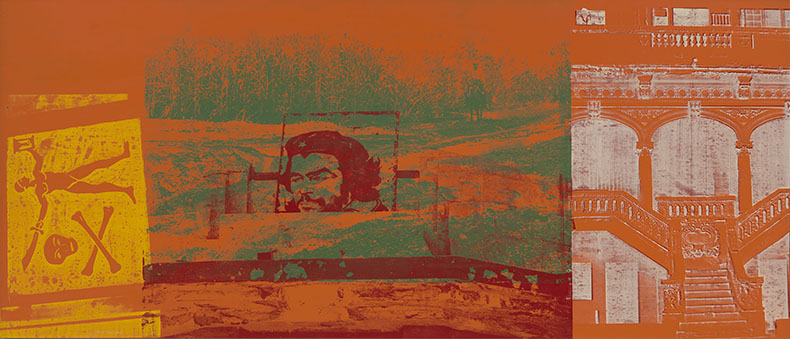
I sense that this aspect of the project is the main reason why ROCI isn’t quite as well known in Rauschenberg’s career as, for instance, his combines. I doubt it’s anything to do with the quality of the art, which is tremendous. The majority of the works are large silkscreened canvases printed with photographs and motifs (some of which are shown here in their original form) Rauschenberg captured in each place, usually blended with paint, fabrics and ‘found’ objects. The whole thing has an aesthetic harmony and yet the works from each country strike a subtly different note. Iban Pak Tanah (Iban Landmark)/ROCI MALAYSIA is a sepia-tinted canvas in which a boar on one side and a pile of logs on the other is bisected by a swash of yellowish paint. Premonition (Ante de Creer)/ROCI CUBA is an orange affair with a printed skull and crossbones and the inevitable face of Che Guevara – an image taken from graffiti. It sits, in a neat curatorial flourish, in Thaddaeus Ropac’s ‘chapel’ gallery, alongside works from the Chile and Soviet Union series, which contain images of Christ and Lenin respectively. Bamhue/ROCI JAPAN (1987) is one of the show’s few sculptural works – a bamboo pole propped against a wall emitting coloured lights that change every 10 seconds or so with a satisfying click. It is recognisably Japanese in its material and simplicity, and yet distinctly Rauschenbergian in its fusion of old and new – a kind of spartan prototype of the neon Bicycloid series he would go on to make in the 1990s.
Onoto Snare/ROCI VENEZUELA (1985), Robert Rauschenberg. Courtesy Thaddaeus Ropac gallery, London, Paris, Salzburg, Seoul; © Robert Rauschenberg Foundation/ARS, New York 2021
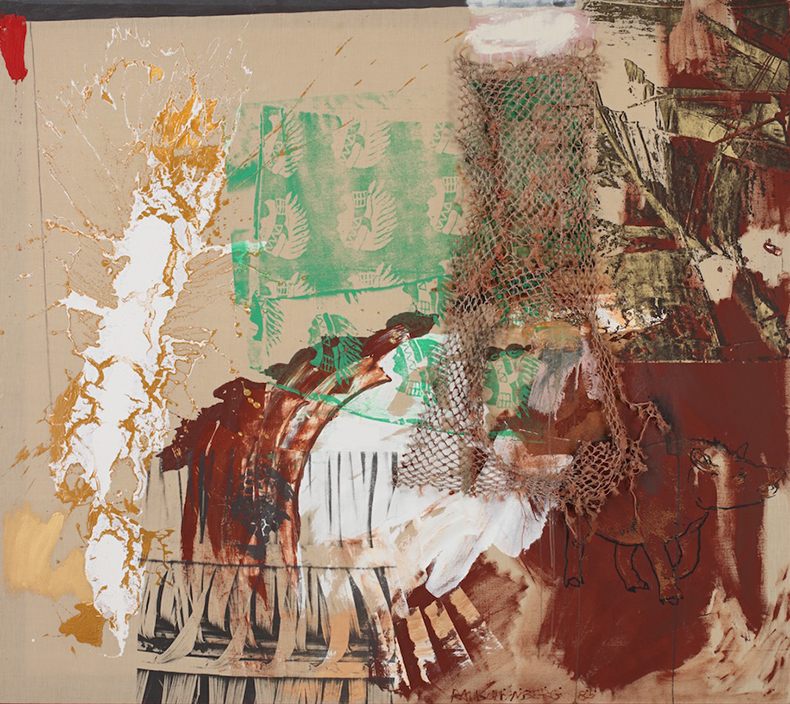
The Venezuelan works are some of the most thrilling: Onoto Snare includes what from afar looks like a sheet of rusted fencing with a hole punched through, but is in fact a fabric weave. Rudy’s House is a black and white splurge, with swirling bench and railing patterns recurring throughout and a black chair protruding from the centre of the canvas. It looks faintly ridiculous as you approach from the side, but front-on the chair blends almost seamlessly into the work, its form perfectly framing a printed dog in the middle. These are the most ingenious of Rauschenberg’s assemblages – those where seemingly random objects combine in unlikely consonance. His Tibet sculpture constructed of two interlinked chairs supporting a typewriter is somewhat underwhelming precisely because each part feels individual and the whole lacks whatever harmonising alchemy the artist managed to summon in his most successful pieces.
It was around this time that Rauschenberg began experimenting with aluminium canvases, and several ROCI works were painted on such sheets. One hangs in the main gallery – Level Revel/ROCI USA (Wax Fire Works) – and as I stare into it I see not only the coloured motifs on its surface, but also myself reflected in the metal, as well as the cardboard tequila boxes hanging on the opposite wall and the three ROCI TIBET sculptures that sit in the middle of the room. It’s the Platonic ideal of a ROCI work: one that not only includes all the things Rauschenberg used as his source material (images, cultures, people, slogans, materials – in other words, the very stuff of the world), but one that also physically reflects in its surface other ROCI works, in a literalisation of the cultural exchange – the ‘1 to 1 contact’ – that its creator so desired.
Installation view of ‘Robert Rauschenberg: ROCI’ at Thaddaeus Ropac, London, 2024. Courtesy Thaddaeus Ropac gallery, London, Paris, Salzburg, Seoul; © Robert Rauschenberg Foundation/ARS, New York 2024
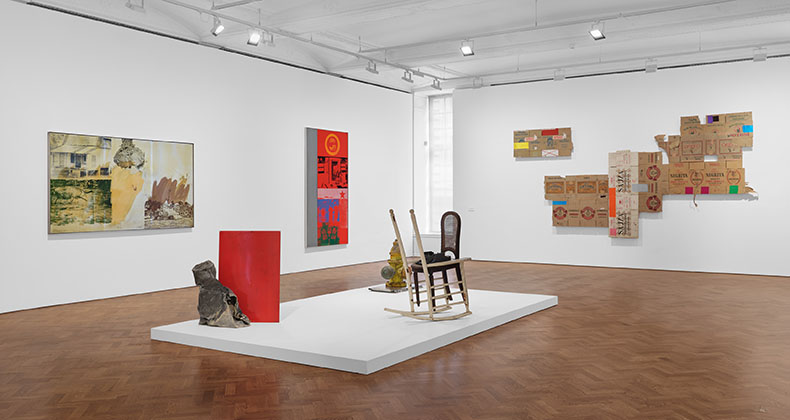
‘Robert Rauschenberg: ROCI’ is at Thaddaeus Ropac, London, until 3 August.

